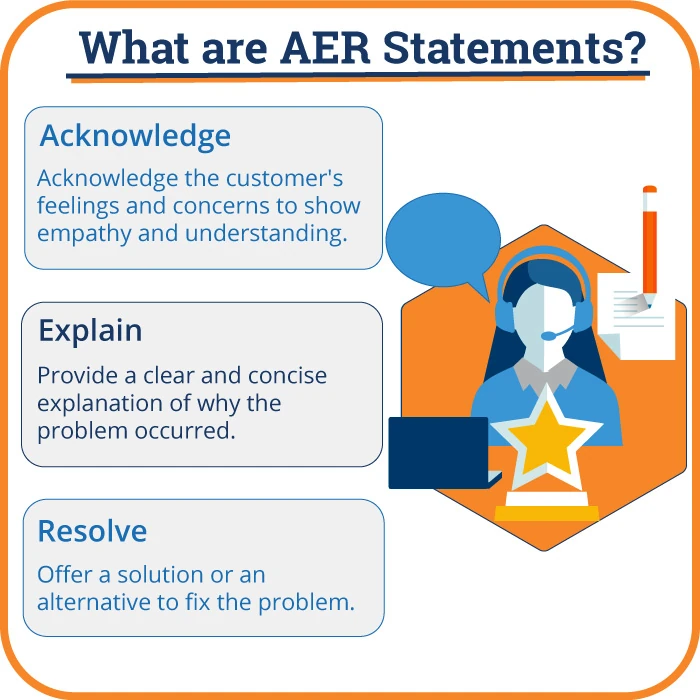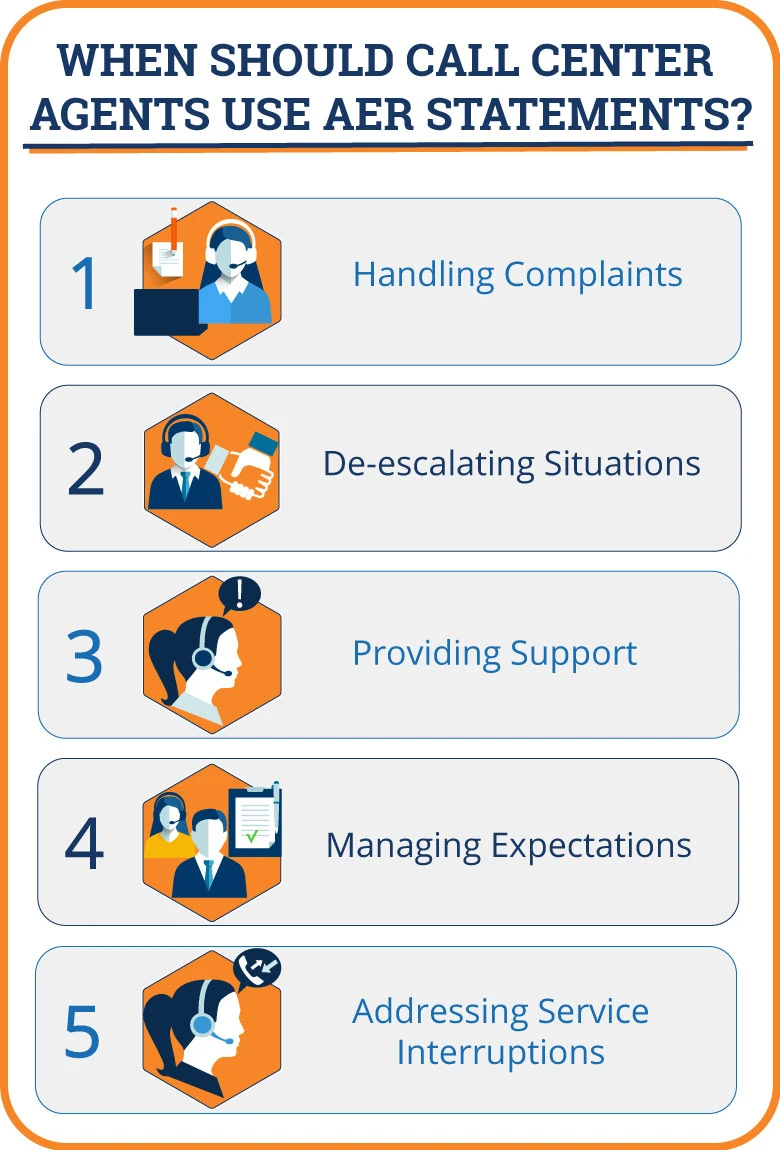As a call center agent, it's essential to know how to talk to customers in a way that makes customers feel comfortable and understood. One great way to do this is by using AER statements, which stands for Acknowledge, Explain, and Resolve.
The AER method helps call center agents handle customer problems in a way that makes them feel heard and cared for. Using AER statements can significantly improve customers' feelings about their experience, making them happier and more satisfied.
What Are AER Statements?
AER statements are a tool that helps call center agents deal with customer questions and complaints. Here's how it works:

Acknowledge
Acknowledge the customer's feelings and concerns to show empathy and understanding. This builds trust and rapport, making the customer feel heard and valued.
For example, use phrases such as:
- "I understand how frustrating this must be for you. Thank you for bringing it to our attention."
- "I can see how this situation could be upsetting. I'm here to help you resolve it."
- "Your concern is completely valid. I'm sorry you're experiencing this issue."
Explain
Provide a clear and concise explanation of why the problem occurred. This transparency helps the customer understand the situation better and reduces anxiety by setting realistic expectations.
The following are good examples of clear and concise explanations:
- "The issue occurred because there was an unexpected delay in our supply chain, which affected your order."
- "This problem is due to a recent system update that caused some technical glitches."
- "We had a temporary outage in our service, which unfortunately affected your account."
Resolve
Offer a solution or an alternative to fix the problem. This step reassures the customer that action is being taken and shows commitment to resolving their issue.
Here are great examples of steps taken by call center agents to help resolve a customer's issue:
- "To resolve this, I've expedited your order, and it should reach you by tomorrow."
- "I've credited your account with a free month of service to make up for the inconvenience."
- "We'll send a technician to your location within the next two hours to fix the issue."
What are the Benefits of Using AER Statements in the Call Center?
AER statements facilitate communication with customers. By acknowledging their issue, you show empathy and make them feel valued. Explaining the situation helps clear up any confusion, and resolving the problem indicates that you are committed to helping them. Together, these steps make customers feel more confident in your service.
1. AER Statements Enhance Customer Satisfaction
The biggest benefit of using AER statements is that it increases customer satisfaction. When customers feel understood and respected, they're more likely to be satisfied with the service. Clear explanations set the right expectations, and fixing problems effectively shows that the company cares about their needs.
2. AER Statements Build Stronger Customer Relationships
AER statements help build rapport and stronger relationships with customers. When customers know they can count on you to listen, understand, and solve their problems, they're more likely to keep coming back and even recommend your service to others.
3. AER Statements Improve Overall Communication Effectiveness
Using AER statements makes communication in the call center clearer and more effective. It gives agents a structured way to handle customer issues, which reduces confusion and frustration. This also helps agents feel more confident and satisfied in their job, leading to better service overall.
When Should Call Center Agents Use AER Statements?

1. Handling Complaints

When customers express dissatisfaction or frustration with a product, service, or experience, they seek validation and a solution to their problem.
Using AER statements helps to acknowledge their frustration, explain the situation transparently, and provide a resolution that meets their needs.
Example:
Acknowledge: "I understand how frustrating this must be for you. Thank you for bringing it to our attention."
This shows empathy and makes the customer feel heard and valued, which can help to reduce their frustration.
Explain: "It looks like the issue occurred because of an error in our system during the recent update."
Providing a clear and honest explanation helps the customer understand why the problem happened, which can alleviate some of their frustration and confusion.
Resolve: "I've corrected the error, and you should see the changes immediately. I'll also ensure that this doesn't happen again in the future."
Offering a prompt and effective solution reassures the customer that their issue is being taken seriously and will be resolved.
2. De-escalating Situations

De-escalating situations is essential to prevent conflicts from escalating and to maintain a positive relationship with the customer.
AER statements help to calm the customer by acknowledging their emotions, providing a reason for the issue, and offering a solution.
Example:
Acknowledge: "I can see this situation is very upsetting for you. I'm here to help."
This shows empathy and helps to defuse the customer's anger, making them more receptive to the explanation and solution.
Explain: "The problem seems to have been caused by a misunderstanding in our communication."
Clarifying the cause of the issue helps the customer understand that it was not intentional and can be resolved.
Resolve: "Let's work together to resolve this. I'll ensure that your concerns are addressed immediately and provide you with regular updates."
Offering a collaborative approach to resolving the issue reassures the customer that their concerns are being prioritized and managed.
3. Providing Support

Providing support effectively ensures customers can use your products or services without issues.
AER statements help to acknowledge the customer's difficulties, explain the cause, and guide them toward a resolution.
Example:
Acknowledge: "I understand you're having trouble with the new software. That can be really frustrating."
This shows empathy and encourages the customer to feel comfortable expressing their concerns.
Explain: "A compatibility problem with certain operating systems usually causes this issue."
Explaining the cause of the issue helps the customer understand that it is a known problem with a logical explanation.
Resolve: "Let's try updating your software to the latest version. If that doesn't work, I'll connect you with a specialist who can provide further assistance."
Offering a step-by-step solution reassures the customer that there is a clear path to resolving their issue.
4. Managing Expectations

Managing expectations is critical when there are delays or changes that impact the customer.
AER statements help to acknowledge the customer's disappointment, explain the reason for the change, and provide a new timeline or solution.
Example:
Acknowledge: "I understand that you were expecting your delivery today. I'm sorry for any inconvenience caused by the delay."
This shows understanding, which can help to mitigate the customer's disappointment.
Explain: "The delay is due to an unexpected backlog at our shipping facility."
Providing a clear explanation helps the customer understand that the delay is beyond your control and is being addressed.
Resolve: "Your order has been prioritized and will be delivered by tomorrow. We'll also provide you with a tracking link for real-time updates."
Offering a concrete solution and keeping the customer informed helps to rebuild their trust and satisfaction.
5. Addressing Service Interruptions

Addressing service interruptions promptly is essential to minimize the impact on the customer.
AER statements help to acknowledge the inconvenience, explain the reason for the interruption, and provide a timeline for resolution.
Example:
Acknowledge: "I apologize for the inconvenience caused by the service interruption. I understand how important this service is for you."
This empathetic response reassures the customer that their issue is being taken seriously.
Explain: "The interruption is due to maintenance work to improve overall service quality."
Explaining the reason for the interruption helps the customer understand that the work is necessary and beneficial in the long run.
Resolve: "The maintenance is expected to be completed within the next hour. We appreciate your patience and will credit your account for the downtime experienced."
Providing a clear timeline for resolution and compensating the customer for the inconvenience helps to maintain their trust and satisfaction.
Tips for Crafting Effective AER Statements
Firstly, using active listening techniques is crucial to fully comprehend what the customer is saying and get a better sense of their emotional state (i.e., are they frustrated or angry?). Active listening means paying full attention to the customer, understanding what they're saying, and responding thoughtfully.
- Active listening techniques include:
- Reflect and Clarify: Repeat what the customer says to ensure you understand.
- Ask Open-Ended Questions: Encourage the customer to share more about their concerns.
Maintain Engagement: Show that you're listening and understanding throughout the conversation.
Secondly, it's important to tailor AER statements to individual customer needs. Each customer is different, so adjusting your responses to fit their specific needs is important.
Adjusting to each customer looks like this:
- Personalize the Response: Use the customer's name and refer to their specific issue.
- Adapt the Solution: Make sure the resolution fits the customer's situation.
- Show Genuine Empathy: Match your tone and words to the customer's emotional state.
